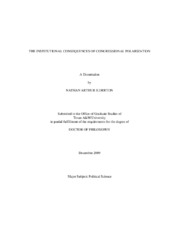| dc.description.abstract | Polarization, defined as the ideological distance between the Democrat and
Republican parties in Congress, has increased dramatically in Congress since the 1970s.
Research on polarization in the U.S. Congress primarily focuses on the sources of this
increase. Relatively little work has been done on the consequences of polarization for
Congress? relationship with the president and the passage of legislation. This
dissertation corrects this omission by examining the influence of polarization on several
key aspects of the legislative process. It examines the impact of polarization on the
interaction between Congress and the president, including the president?s strategy in
supporting or opposing legislation and the success the president has on bills when he
takes a position. It also examines the effect polarization has on the overall passage of
legislation. An empirical examination was undertaken using significant bills in
Congress over a sixty year time period (1947-2006).
The results indicate that the effects of polarization on the legislative process are
contingent upon the presence of divided government, defined as times when the
president and a majority of members of Congress are from different parties, and the
chamber of Congress under examination. As polarization increases, the president is more likely to support legislation and be successful when his party controls Congress,
but he opposes more legislation and is less successful as polarization increases under
divided government. Legislative gridlock, the inability of Congress to pass important or
innovative legislation, tends to decrease in both the House and Senate as polarization
increases under unified government. However, as polarization increases under divided
government the overall passage of bills into law decreases.
The dissertation also offers an improved method for modeling the impact of
divided government on gridlock. Prior studies model divided government without
regard for whether the president takes a position on a given bill. This study shows that
when the president takes a position on a bill under divided government the probability it
passes decreases, but the probability of passage increases when the president does not
take a position. This finding implies that previous research may underestimate the true
effects of divided government on gridlock. | en |


